2013年11月15日開催OAUG JDE SIGセミナー ジェクシード消費税改正対応サービス
0 likes285 views
2013年11月15日開催OAUG JDE SIGのセミナー資料 内容は2013年11月時点のサービスです。
1 of 9


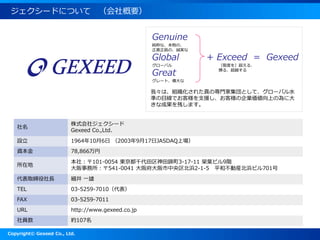
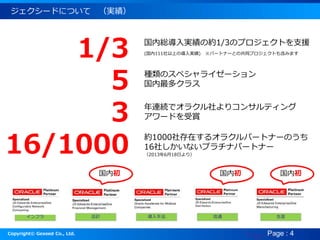
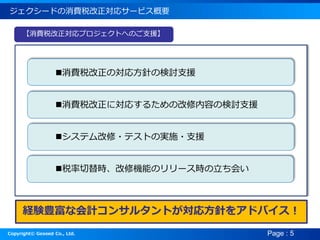
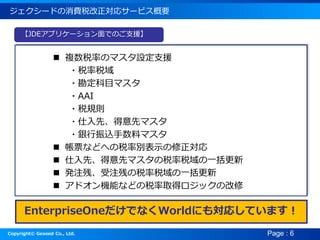
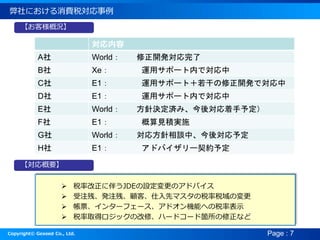
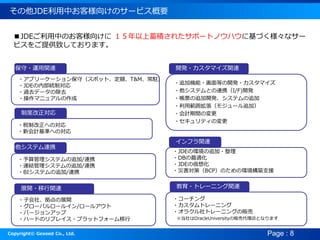

Ad
Recommended
贤く思われる6つのコツ
贤く思われる6つのコツShoe-g Ueyama
?
大きく分けて下の2つのことを書いてます
?分かりやすく話すコツ3つ
?価値あることを話すための3つのコツ
Created by Shoe-G Ueyama http:///www.shoe-g.com/DevOps勉強会の発表で使った資料 #devops_LT
DevOps勉強会の発表で使った資料 #devops_LTTomohiro Furuta
?
2010/11/26に株式会社Loco Partners主催によるDevOps勉強会を行いました。その時の発表で使った資料です。
小さい組織ながら、すでに発生し始めたホウレンソウ不足の問題に対して、仕組みを変えるという側面からTrelloを活用して解決に挑んだ話です。
エンジニア募集についてはこちらよりどうぞ。IVS CTO NightのLTで使った資料 #ctonight
IVS CTO NightのLTで使った資料 #ctonightTomohiro Furuta
?
2010/12/2?4に京都で開催されたIVS CTO Night & Day 2014に参加しました。初日の夜で行われたLT大会で登壇させていただいた時の資料です。心のリミッター外す方法
心のリミッター外す方法Shoe-g Ueyama
?
BMX(自転車競技)で12年間で45回国内外の高いで優勝をした経験から、自分のリミッターを切る方法を学びました。
それをスライドにしてます
ここで僕がプレゼンしている動画見れます
↓↓↓↓
http://www.ustream.tv/recorded/23718395???? ???? ???? ????
???? ???? ???? ????Dr. Peri Sinclair
?
文档讨论了多个主题,涉及社交互动、文化交流和个人发展等方面。特别关注了如何通过有效的沟通和互相理解来提升人际关系。整体内容强调了相互尊重和开放思想的重要性。JD Edwards & Peoplesoft 1 _ Doug Hughes _ Oracle applications strategy and ro...
JD Edwards & Peoplesoft 1 _ Doug Hughes _ Oracle applications strategy and ro...InSync2011
?
The document outlines Oracle's strategy and roadmap for its applications products. It discusses Oracle's commitment to supporting current product lines through ongoing enhancements and releases. It also introduces Fusion Applications as the next generation of applications that are being developed on a new platform. The roadmap shows investment across various Oracle applications with new releases scheduled over the next few years.Erp
ErpArmaan Shahi
?
Enterprise resource planning (ERP) is a type of business management software that allows organizations to use a system of integrated applications to manage important business processes like manufacturing, supply chain, customer relationship management, and finance. ERP aims to integrate all departments and functions within a company onto a single computer system. This consolidation provides advantages like easy sharing of information between departments, automated workflows, reduced communication gaps, lower inventory costs and lead times, and standardized business processes. Major ERP software packages include SAP, Oracle PeopleSoft, and JD Edwards. SAP is one of the largest ERP providers and its various modules allow companies to effectively manage finances, materials, production, quality, maintenance and human resources.Jdedwards EnterpriseOne Implementing Workflow
Jdedwards EnterpriseOne Implementing WorkflowSergio Vargas
?
The document discusses the implementation and features of JD Edwards EnterpriseOne workflow automation, which transforms paper-based business processes into efficient email-based processes. It highlights tools for mapping business processes, routing messages, and handling approvals to streamline operations and reduce errors. Additionally, it outlines technical capabilities for administrators, including workflow message management and user interaction via email and work centers.Protecting What Matters...An Enterprise Approach to Cloud Security
Protecting What Matters...An Enterprise Approach to Cloud SecurityInnoTech
?
This document discusses cloud security from an enterprise perspective. It begins by outlining trends in security threats facing organizations and the challenges of managing risk. It then provides guidance on taking a risk-based approach to cloud security, designing applications securely for the cloud, and conducting ongoing auditing and management. The key recommendations are to understand your risk profile, architect for security in cloud environments, implement robust identity and access management, confirm compliance obligations, and define clear security responsibilities between customers and cloud service providers.Jd edward ppt by me
Jd edward ppt by meroma bora
?
This document provides an overview of the JD Edwards Enterprise One ERP software. It discusses that JD Edwards was originally founded in 1977 and was acquired by Oracle. It describes the main modules of JD Edwards Enterprise One including financial management, project management, asset lifecycle management, order management, manufacturing management, and reporting. It also discusses the mobile capabilities and generations of the JD Edwards ERP software.JDE & Peoplesoft 1 | John Schiff | JD Edwards Go9.pdf
JDE & Peoplesoft 1 | John Schiff | JD Edwards Go9.pdfInSync2011
?
1) The document discusses Oracle's JD Edwards product line, including growth in sales and customer satisfaction rates. It highlights recent wins and analyst reports confirming the value of JD Edwards.
2) It provides an overview of the latest releases of JD Edwards EnterpriseOne applications and tools over the past 6 years, and test results showing improved performance and scalability on Oracle Exadata and Exalogic platforms.
3) The presentation outlines Oracle's roadmap for upcoming JD Edwards releases, including improvements to usability, mobile access, industry solutions, and global compliance features. It also discusses support timelines and benefits of upgrading to the latest releases.Introduction to Oracle ERP
Introduction to Oracle ERPBalaji Parsewar
?
Oracle provides various enterprise applications and middleware products. It recently acquired several companies and has over 55,000 employees generating $12B in annual sales. Oracle is committed to protecting customers' existing application investments while providing more functionality through a lower total cost of ownership. Oracle plans to continue developing its existing application product lines and integrating them on a service-oriented architecture using standards-based Fusion Middleware. This will allow for more flexible and cost-effective integration of business processes.セルフストーリーチャート集団受講プログラム0期生募集のご案内_株式会社Your Verse
セルフストーリーチャート集団受講プログラム0期生募集のご案内_株式会社Your Versejokada1
?
セルフストーリーチャートの集団受讲プログラムを开讲します。正规募集のまえに0期生(モニター)を募集いたします。CISM Governance Risk Integration - Japanese
CISM Governance Risk Integration - JapaneseTokyo Security Community
?
CISM Governance Risk Integration自律型人材が育つ1on1ミーティングの教科書 ~累計2万人のマネジャーに1on1研修を実施してきた専門家が解説
自律型人材が育つ1on1ミーティングの教科書 ~累計2万人のマネジャーに1on1研修を実施してきた専門家が解説sevenfoldbliss
?
部下のフェーズ(状態?段階)に合わせた1on1ミーティングを行なえていますか?
有料級の情報を全24ページに渡りお届けいたします!More Related Content
What's hot (6)
心のリミッター外す方法
心のリミッター外す方法Shoe-g Ueyama
?
BMX(自転車競技)で12年間で45回国内外の高いで優勝をした経験から、自分のリミッターを切る方法を学びました。
それをスライドにしてます
ここで僕がプレゼンしている動画見れます
↓↓↓↓
http://www.ustream.tv/recorded/23718395???? ???? ???? ????
???? ???? ???? ????Dr. Peri Sinclair
?
文档讨论了多个主题,涉及社交互动、文化交流和个人发展等方面。特别关注了如何通过有效的沟通和互相理解来提升人际关系。整体内容强调了相互尊重和开放思想的重要性。Viewers also liked (8)
JD Edwards & Peoplesoft 1 _ Doug Hughes _ Oracle applications strategy and ro...
JD Edwards & Peoplesoft 1 _ Doug Hughes _ Oracle applications strategy and ro...InSync2011
?
The document outlines Oracle's strategy and roadmap for its applications products. It discusses Oracle's commitment to supporting current product lines through ongoing enhancements and releases. It also introduces Fusion Applications as the next generation of applications that are being developed on a new platform. The roadmap shows investment across various Oracle applications with new releases scheduled over the next few years.Erp
ErpArmaan Shahi
?
Enterprise resource planning (ERP) is a type of business management software that allows organizations to use a system of integrated applications to manage important business processes like manufacturing, supply chain, customer relationship management, and finance. ERP aims to integrate all departments and functions within a company onto a single computer system. This consolidation provides advantages like easy sharing of information between departments, automated workflows, reduced communication gaps, lower inventory costs and lead times, and standardized business processes. Major ERP software packages include SAP, Oracle PeopleSoft, and JD Edwards. SAP is one of the largest ERP providers and its various modules allow companies to effectively manage finances, materials, production, quality, maintenance and human resources.Jdedwards EnterpriseOne Implementing Workflow
Jdedwards EnterpriseOne Implementing WorkflowSergio Vargas
?
The document discusses the implementation and features of JD Edwards EnterpriseOne workflow automation, which transforms paper-based business processes into efficient email-based processes. It highlights tools for mapping business processes, routing messages, and handling approvals to streamline operations and reduce errors. Additionally, it outlines technical capabilities for administrators, including workflow message management and user interaction via email and work centers.Protecting What Matters...An Enterprise Approach to Cloud Security
Protecting What Matters...An Enterprise Approach to Cloud SecurityInnoTech
?
This document discusses cloud security from an enterprise perspective. It begins by outlining trends in security threats facing organizations and the challenges of managing risk. It then provides guidance on taking a risk-based approach to cloud security, designing applications securely for the cloud, and conducting ongoing auditing and management. The key recommendations are to understand your risk profile, architect for security in cloud environments, implement robust identity and access management, confirm compliance obligations, and define clear security responsibilities between customers and cloud service providers.Jd edward ppt by me
Jd edward ppt by meroma bora
?
This document provides an overview of the JD Edwards Enterprise One ERP software. It discusses that JD Edwards was originally founded in 1977 and was acquired by Oracle. It describes the main modules of JD Edwards Enterprise One including financial management, project management, asset lifecycle management, order management, manufacturing management, and reporting. It also discusses the mobile capabilities and generations of the JD Edwards ERP software.JDE & Peoplesoft 1 | John Schiff | JD Edwards Go9.pdf
JDE & Peoplesoft 1 | John Schiff | JD Edwards Go9.pdfInSync2011
?
1) The document discusses Oracle's JD Edwards product line, including growth in sales and customer satisfaction rates. It highlights recent wins and analyst reports confirming the value of JD Edwards.
2) It provides an overview of the latest releases of JD Edwards EnterpriseOne applications and tools over the past 6 years, and test results showing improved performance and scalability on Oracle Exadata and Exalogic platforms.
3) The presentation outlines Oracle's roadmap for upcoming JD Edwards releases, including improvements to usability, mobile access, industry solutions, and global compliance features. It also discusses support timelines and benefits of upgrading to the latest releases.Introduction to Oracle ERP
Introduction to Oracle ERPBalaji Parsewar
?
Oracle provides various enterprise applications and middleware products. It recently acquired several companies and has over 55,000 employees generating $12B in annual sales. Oracle is committed to protecting customers' existing application investments while providing more functionality through a lower total cost of ownership. Oracle plans to continue developing its existing application product lines and integrating them on a service-oriented architecture using standards-based Fusion Middleware. This will allow for more flexible and cost-effective integration of business processes.Ad
Recently uploaded (7)
セルフストーリーチャート集団受講プログラム0期生募集のご案内_株式会社Your Verse
セルフストーリーチャート集団受講プログラム0期生募集のご案内_株式会社Your Versejokada1
?
セルフストーリーチャートの集団受讲プログラムを开讲します。正规募集のまえに0期生(モニター)を募集いたします。CISM Governance Risk Integration - Japanese
CISM Governance Risk Integration - JapaneseTokyo Security Community
?
CISM Governance Risk Integration自律型人材が育つ1on1ミーティングの教科書 ~累計2万人のマネジャーに1on1研修を実施してきた専門家が解説
自律型人材が育つ1on1ミーティングの教科書 ~累計2万人のマネジャーに1on1研修を実施してきた専門家が解説sevenfoldbliss
?
部下のフェーズ(状態?段階)に合わせた1on1ミーティングを行なえていますか?
有料級の情報を全24ページに渡りお届けいたします!Ad
2013年11月15日開催OAUG JDE SIGセミナー ジェクシード消費税改正対応サービス
- 1. About Gexeed : http://www.gexeed.co.jp Copyright? Gexeed Consulting Co., Ltd. 株式会社ジェクシード Gexeed Co,.Ltd. 消費税改正対応サービスのご紹介 2013年11月15日
- 2. Copyright? Gexeed Co., Ltd. Page : 2 アジェンダ 1.ジェクシードについて 2.ジェクシードの消費税改正対応サービス概要 3.弊社における消費税対応事例 4.その他JDE利用中お客様向けのサービス概要
- 3. Copyright? Gexeed Co., Ltd. ジェクシードについて (会社概要) 社名 株式会社ジェクシード Gexeed Co.,Ltd. 設立 1964年10月6日 (2003年9月17日JASDAQ上場) 資本金 78,866万円 所在地 本社:〒101-0054 東京都千代田区神田錦町3-17-11 榮葉ビル9階 大阪事務所:〒541-0041 大阪府大阪市中央区北浜2-1-5 平和不動産北浜ビル701号 代表取締役社長 細井 一雄 TEL 03-5259-7010(代表) FAX 03-5259-7011 URL http://www.gexeed.co.jp 社員数 約107名 Genuine 純粋な、本物の、 正真正銘の、誠実な Global グローバル Great グレート、偉大な + Exceed = Gexeed 〔限度を〕超える、 勝る、超越する 我々は、組織化された真の専門家集団として、グローバル水 準の目線でお客様を支援し、お客様の企業価値向上の為に大 きな成果を残します。
- 4. Copyright? Gexeed Co., Ltd. Page : 4 1/3 5 3 16/1000 国内総導入実績の約1/3のプロジェクトを支援 (国内111社以上の導入実績) ※パートナーとの共同プロジェクトも含みます 種類のスペシャライゼーション 国内最多クラス 年連続でオラクル社よりコンサルティング アワードを受賞 国内初 国内初 インフラ 会計 導入手法 流通 生産 国内初 約1000社存在するオラクルパートナーのうち 16社しかいないプラチナパートナー (2013年6月18日より) ジェクシードについて (実績) Page: 4
- 5. Copyright? Gexeed Co., Ltd. Page : 5 ジェクシードの消費税改正対応サービス概要 【消費税改正対応プロジェクトへのご支援】 ?消費税改正の対応方針の検討支援 ?消費税改正に対応するための改修内容の検討支援 ?システム改修?テストの実施?支援 ?税率切替時、改修機能のリリース時の立ち会い 経験豊富な会計コンサルタントが対応方針をアドバイス!
- 6. Copyright? Gexeed Co., Ltd. Page : 6 ジェクシードの消費税改正対応サービス概要 ? 複数税率のマスタ設定支援 ?税率税域 ?勘定科目マスタ ?AAI ?税規則 ?仕入先、得意先マスタ ?銀行振込手数料マスタ ? 帳票などへの税率別表示の修正対応 ? 仕入先、得意先マスタの税率税域の一括更新 ? 発注残、受注残の税率税域の一括更新 ? アドオン機能などの税率取得ロジックの改修 【JDEアプリケーション面でのご支援】 EnterpriseOneだけでなくWorldにも対応しています!
- 7. Copyright? Gexeed Co., Ltd. Page : 7 弊社における消費税対応事例 ? 税率改正に伴うJDEの設定変更のアドバイス ? 受注残、発注残、顧客、仕入先マスタの税率税域の変更 ? 帳票、インターフェース、アドオン機能への税率表示 ? 税率取得ロジックの改修、ハードコード箇所の修正など 対応内容 A社 World: 修正開発対応完了 B社 Xe: 運用サポート内で対応中 C社 E1: 運用サポート+若干の修正開発で対応中 D社 E1: 運用サポート内で対応中 E社 World: 方針決定済み、今後対応着手予定) F社 E1: 概算見積実施 G社 World: 対応方針相談中、今後対応予定 H社 E1: アドバイザリー契約予定 【お客様概況】 【対応概要】
- 8. Copyright? Gexeed Co., Ltd. Page : 8 その他JDE利用中お客様向けのサービス概要 ?アプリーケーション保守(スポット、定額、T&M、常駐) ?JDEの内部統制対応 ?過去データの除去 ?操作マニュアルの作成 ?追加機能?画面等の開発?カスタマイズ ?他システムとの連携(I/F)開発 ?帳票の追加開発、システムの追加 ?利用範囲拡張(モジュール追加) ?会計期間の変更 ?セキュリティの変更 ?子会社、拠点の展開 ?グローバルロールイン/ロールアウト ?バージョンアップ ?ハードのリプレイス?プラットフォーム移行 ?コーチング ?カスタムトレーニング ?オラクル社トレーニングの販売 ※当社はOracleUniversityの販売代理店となります ?予算管理システムの追加/連携 ?連結管理システムの追加/連携 ?BIシステムの追加/連携 保守?運用関連 開発?カスタマイズ関連 教育?トレーニング関連展開?移行関連 他システム連携 ?税制改正への対応 ?新会計基準への対応 制度改正対応 ?JDEの環境の追加?整理 ?DBの最適化 ?JDEの仮想化 ?災害対策(BCP)のための環境構築支援 インフラ関連 ■JDEご利用中のお客様向けに 15年以上蓄積されたサポートノウハウに基づく様々なサー ビスをご提供致しております。
- 9. Copyright? Gexeed Co., Ltd. Page : 9 株式会社ジェクシード TEL:03-5259-7010 FAX:03-5259-7011 URL: http://www.gexeed.co.jp
